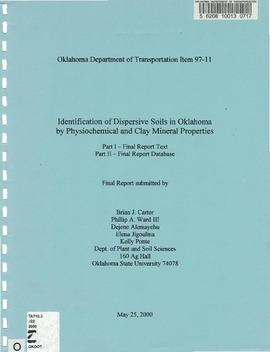Identification of dispersive soils in Oklahoma by physiochemical and clay mineral properties (97-11)
Abstract
Twenty-three soils were sampled across Oklahoma to determine sodic-dispersive characteristics. Twenty-two soils contained sodic properties in some part of their subsoil (within 2 m of the soil surface). Only one of the twenty-two soils was not dispersive as measured by the double hydrometer test. Sodic soils are identified in county soil surveys (NRCS, USDA). County soil surveys can be used to determine areas of
sodic soils for many Oklahoma counties. Soil series names used in county soil surveys often did not match or fit soils sampled in this study. Field soil profile descriptions contained only siltans as salient indicators of sodic soils conditions. The presence of siltans failed to predict sodic conditions in the lower subsoil compared to the upper subsoil. Choctaw County contains sodic soils but current soil survey information for this county does not identify soil mapping units that contain sodic soils. Values for soil SAR and EC can be used to predict dispersive soil. The double hydrometer and pinhole tests used together can also predict soil dispersion. The crumb test should not be used as a quick field soil test to predict soil dispersion. Dispersive soils contained a preclominance of interstratified illite-smectite clays.
The presence of vermiculite and kaolinite in some soils clecreased dispersion compared to interstratified illite-smectite. Increased gypsum, bicarbonate, and salt eoatent in soil horizons decreased dispersion compared to soil horizons with low amounts of these materials. Gypsum and leaching with water are proposed amendments for selected sodic soils in Oklahoma.
